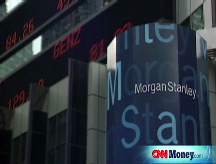The new Wall St: Same as the old one
Goldman Sachs and Morgan Stanley face a tough road as they expand into traditional banking. But some analysts say neither firm will change that much.
NEW YORK (CNNMoney.com) -- The decision by Goldman Sachs and Morgan Stanley to recast themselves as bank holding companies over the weekend may shake up the nation's banking landscape.
Then again, it may not.
After capturing outsized profits over the years, both firms may be reluctant to forsake their trusted investment banking model altogether, according to some analysts. And given their relative lack of sophistication in the traditional banking business, both Goldman and Morgan are certainly at a disadvantage along that front.
Both Wall Street firms have already dabbled in the commercial banking business even before the current crisis erupted. Morgan Stanley had more than 3 million retail accounts and $36 billion in bank deposits as of the end of August. Between its domestic and European bank outfits, Goldman Sachs held more than $20 billion in customer deposits.
But those numbers are a far cry from the retail branch footprint of, say, a JPMorgan Chase (JPM, Fortune 500) or Bank of America (BAC, Fortune 500), which had $440 billion and $663 billion in deposits respectively on a pro forma basis, according to research firm SNL Financial.
Both Goldman and Morgan have said either explicitly, or otherwise, that they plan to build their existing, albeit relatively small, deposit bases either through acquisitions or organically.
Acquisitions seem logical since an increasing number of banks are expected to fail in the months ahead.
But it's not a given that the Federal Deposit Insurance Corp. would rush to hand deposits of collapsed banks to Goldman or Morgan since other regional banks may be better suited to acquire them.
"[Goldman and Morgan] have this goal to expand retail deposits to some extent, but they face a lot of competition," said Richard Staite, a banking analyst with the London-based Atlantic Equities.
A dozen banks have failed so far this year and eleven have already been acquired. Many of those were probably too small to be of interest to Goldman or Morgan anyway.
However, the only bank that the FDIC has failed to find a buyer for so far is the California-based mortgage lender IndyMac, which had $19 billion in deposits when federal regulators seized it in July.
Staite said that companies that already have a significant commercial bank presence are arguably more nimble and better suited to pull off a deal for a depository institution such as IndyMac or another mid-sized or large bank that fails in the future, than Goldman or Morgan.
"Other banks may be in a better position to absorb a branch network and integrate it," said Staite. "It is difficult to see how Goldman would fit an acquired branch network into its business."
Arguably, the move by Goldman and Morgan to convert into bank holding companies was done largely out of a need to survive.
By mid-week, both institutions were suffering the tell-tale signs of a "run on the bank." Short-term funding sources, considered crucial for investment banks, began to dry up. Hedge fund clients were reportedly cutting ties altogether and both institutions were suffering drastic stock declines.
Fearing they could suffer the same fate as rival Lehman Brothers, both firms sought shelter at the Federal Reserve, getting in return all the same borrowing privileges from the Fed as their commercial banking peers.
While that change will certainly mean greater oversight by regulators and that neither firm will be able to rely on leverage to boost profits, it doesn't mean that either company will have to shun their day-to-day business activity like sales and trading, underwriting or deal advisory, notes Richard Bove, an analyst with Ladenburg Thalmann.
"Their trading operations are not going to be cut back, they are still going to make equity investments into companies," said . "Will it change their business? I don't think so."
What seems unlikely, at least in the near term, is that either firm might engage in a high-profile tie-up, according to analysts.
In light of Monday's move by Morgan Stanley to sell as much as 20% of itself to Japanese financial giant Mitsubishi UFJ, it seems increasingly doubtful that Morgan Stanley would acquire beleaguered Wachovia (WB, Fortune 500) - a subject of much speculation in recent days.
And if both Goldman and Morgan are indeed in as bad shape as some analysts suspect, it is unlikely that regulators would allow either firm to do a deal, said Robert DeYoung, a professor of finance at University of Kansas' School of Business.
"It could happen, but if an institution is troubled that is one thing that regulators prevent: troubled institutions from making acquisitions," said DeYoung, a former economist at the Federal Reserve Bank of Chicago.
Were Goldman to embrace its newfound status, the firm could soon could establish a bank targeted towards high net-worth clients or refashion itself to look more like an asset management firm like the Chicago-based Northern Trust (NTRS, Fortune 500), said Nancy Bush, managing member at investment advisory firm NAB Research LLC.
Morgan Stanley, on the other hand, could go the route of peers like JPMorgan Chase or Citigroup (C, Fortune 500) by adopting the universal bank model, she noted.
Morgan Stanley has already tried this approach. In 1997, Morgan Stanley merged with consumer finance company Dean Witter, Discover & Co., which ultimately strengthened Morgan Stanley's asset management business.
However, Morgan Stanley spun-off Discover in June 2007, saying that separating the two units would benefit both companies.
But DeYoung envisions a different end game for Morgan and Goldman. Given their diminished status in the new banking world, it's not outrageous to consider that either firm could be gobbled up several years down the road by a commercial bank looking to diversify.
"It just seems to be the natural flow of things," he said. ![]()




